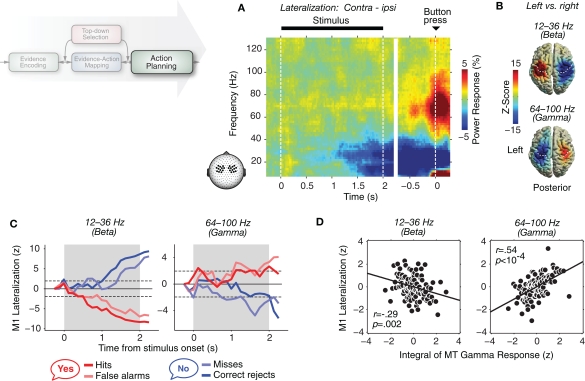Figure 3.
Oscillatory population activity in motor cortex reflects the evolving action plan. (A) Time–frequency representation of lateralized neural activity recorded at MEG sensors overlying motor cortex during the motion-detection task. The lateralization displays the difference in activity contralateral minus ipsilateral to the side of the button-press. (B) Cortical distribution of the lateralized activity (left- minus right-hand button-press) in the beta- and gamma-band during the 0.5 s before button-press. This effector-selective activity is localized to the motor cortex. (C) Time courses of choice-predictive lateralized beta- and gamma-band activity (contralateral minus ipsilateral to “yes” button) in M1, expressed as z-scores for the four trial categories. The shaded area marks the time of stimulus presentation. The mapping of perceptual choices (“yes”/“no”) onto hand movements (left/right) was counterbalanced across subjects. Dashed lines indicate significance levels (p = 0.05 by two-sided t test). (D) Linear regression between the temporal integral of gamma-band activity in MT across the stimulus interval (64–100 Hz) and the lateralized beta- and gamma-band activity in M1 (contralateral minus ipsilateral to “yes’” button) at the end of the stimulus interval. Responses were binned (100 trials per bin) by the MT response integral and z-transformed. Reprinted and modified with permission from Donner et al. (2009).

